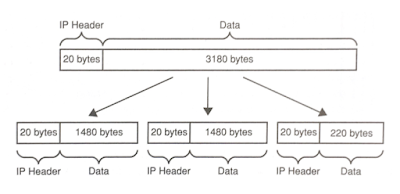Internet Protocol (IP) provides a useful mechanism for communication between various computers and devices.
For example; a uniform addressing system allows communication between computers/device from one network to another (including remote networks) (Simpson, 2006).
Just like a telephone number, an IP address is a mechanism that uniquely identifies different computers/devices on a network, and allows them to contact each other and exchange information (data) using various network technologies (Simpson, 2006).
IP is connectionless; this means that the information (video, audio, data) to be transmitted is broken up into subunits (known as packets), and each subunit can take any available path to reach the receiver from the sender (Simpson, 2006).
IP depends on various software and hardware to function. It is not a user application or an application protocol, however various user applications employ IP to accomplish their tasks (Simpson, 2006).
There are two versions of IP, IPv4 and IPv6.
IPv4 is the most widely used version of IP today, and it used a 32-bit addressing scheme broken into four 8-bit numbers separated by dots. e.g. 192.168.0.31. IPv6 uses a 128bits addressing scheme, fe80::4032:44bc:d244:4ccd is an example IPv6 address (Simpson, 2006).
IP could be seen as a delivery service for "datagrams.", which is a single, logical block of data to sent over IP, with particular format and content rules (Simpson, 2006).
The maximum size of a single datagram transmittable over a standard Ethernet link is 1500 bytes, as defined in IETF RFC 894 and is known as the Maximum Transmission Unit (MTU) (Simpson, 2006).
So if an IP has a datagram that is 3200 bytes long, this will be fragmented into various parts before transmission. See the figure below.
 |
| IP datagram fragmented into various parts |
There are only a little over 4 billion unique IPv4 addresses available; this is quite limited considering the billions of people in the world and the number of devices each person may have access to — this was one of the reasons why IPv6 was created (Simpson, 2006).
However, to solve the problem in the IPv4 domain two network technologies were invented.
- Dynamic Host Configuration Protocol (DHCP) which assigns a temporary IP address to each device on a network.
- and Network Address Translation (NAT) which allows multiple devices to share a single IP address.
The network DHCP server keeps a pool of IP addresses in its database, each time a computer/device connects to the network, an IP address is automatically assigned to the device, when the device disconnects the allotted IP address is returned to the free-pool and is available for any other device that connects to the network (Simpson, 2006).
NAT operates by translating addresses between two different address spaces.
For video transport, the idea of DHCP and NAT can pose some challenges. So as a general rule, video devices that are used to supply content to other clients should have a fixed IP address, and this should not be behind a NAT device (Simpson, 2006).
Ethernet
Ethernet is one of the most widely used physical networking systems for IP traffic and the dominate data-link layer used in broadcast facilities (Simpson, 2006).Invented in the 1970s as a means to interconnect workstations on a local area network (LAN).
MAC addresses
Ethernet Media Access Control (MAC) addresses are programmed permanently into the network interface by the manufacturer and cannot be changed during the life of the equipment. IEEE administers the issuing of MAC address numbers. They are used to identify devices on a network (Simpson, 2006).MAC addresses are 6 bytes long and use a combination of numbers between 0-9 and letter A-F, separated into six fields of two characters each. e.g 00:01:02:6A:F3:81. the first six digits can be used to identify the manufacturer of the device (Simpson, 2006).
Ethernet Switching
Ethernet switching has caused a revolution in data networking. With switching, each device owns all the bandwidth on its link. No sharing and no collisions. Incoming frames are forwared only to nodes that need them (Church and Pizzi, 2010).Multicast
Multicast means that multiple receivers may "tune in" to the transmission. one source's packets input to the system can be received by any number of output nodes (Church and Pizzi, 2010).Reference
Church, S. and Pizzi, S. (2010). Audio over IP. Burlington, MA: Focal Press.Simpson, W. (2006). Video Over IP: A Practical Guide to Technology and Applications (Focal Press media technology professional). Focal Press, pp.163-182,211-250.




Post a Comment